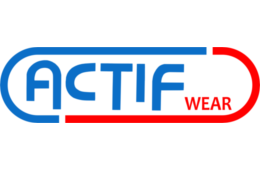Embroidering your garments
Adding an Embroidered logo, and/or piece of text, is at the top end, and often the most expensive, decoration option when customising your garments. However, the quality is amazing and the decoration is likely to last, and look good, for as long as the garment is worn.
Embroidery is the embellishment of fabric or garments with a decorative design made up of from a series of stitches. Historically, embroidery was done by hand. Actifwear, and all other commercial operations, now use computerized machines and a framing/hooping system for decorating garments. The garment material is held tight in a hoop (with a piece of bio-degradable backing material behind it) and clamped underneath the needles. The machine then gives a set of instructions to the needles, which embroider the design onto the fabric.
Each machine has a series of 'Heads/stations' which determines how many garments can be embroidered at one time. Our overall in-house capacity enables us to embroider between 5,000-10,000 units per week. Each head contains up to 15 different needles, meaning that each embroidered design can incorporate up to 15 different coloured threads. This means that quite complex, multi-coloured designs can be achieved.
Embroidery Advantages
- Intricate, multi-colour designs are no problem with modern digitising techniques and machinery
- Pricing not related to amount of colours used
- Hundreds of thread colour options (Pantone matching available)
- Professional looking, long lasting and durable (minimal deterioration with washing)
- Most Material types and locations on garments are fine to embroider
Embroidery Dis-Advantages
- Expensive for large design areas
- Difficult to replicate tonal/photographic effects
- Very small lettering is difficult to achieve
- Slightly longer production and lead time than printing (depending on stitch count)
Screen printing
Traditional / Direct Screen printing involves printing ink directly on to the garment fabric through a number (one screen per colour) of mesh covered aluminium screens.
The design (for the required colour) is printed onto a film positive in opaque black ink. This is then placed onto the screen (that is coated in photo-sensitive emulsion) and exposed to UV light. The non-exposed area is then washed away using water, and the resulting stencil image is then revealed on the screen.
Ink is placed on the screen, and a squeegee is used to push the ink through the stencil image (and mesh) and onto clothing. The printed garment is then dried by being passed through a gas heater.
Screen Printing Advantages
- Cost effective for large bulk orders (20+, 1-colour)
- Fine design detail is possible
- Endless ink colour options (including Pantone matching)
- Long lasting Print technique
- Size of print doesn't affect price
Screen Printing Dis-Advantages
- Not possible for small orders (<20pcs)
- Expensive for multi-colour designs
- Limited by fabric type (i.e difficult to print/cure elastane)
- Limited by print position (i.e difficult to print near seams)
Transfer printing
Transfer printing is the application of a printed media onto your garment, using a heat press. There are a few different types of transfer:
- Digital Transfer - The design is digitally printed onto either White (for dark coloured garments) or Clear (for White garments) film. The design is then 'cut' using precision blades and 'weeded' from the film substrate. The design is then ready to be heat-pressed onto the item of clothing.
- Pre-Printed Transfers - This is where a 1-colour design is 'cut' from a roll of pre-coloured film , 'weeded' and heat pressed onto garments.
- Screen-Transfers - The design is screen printed onto a transfer paper in reverse, then applied to the garment using a heat press.
Transfer Printing Advantages
- Photographic, highly detailed images are possible
- Ideal for Individual Number or Nickname personalisation
- Can be applied to most different material types and decoration areas
- Cost effective for small order quantities (10-25)
- Most transfers can be stored for use at a later date
Transfer Printing Dis-Advantages
- Expensive for large design areas
- Can have a slightly 'plasticky' feel
- Takes longer per print than screen printing
